CHAPTER 17
MILITARY INTELLIGENCE: ALSOS III—GERMANY
Alsos began its operations in Germany on February 24, 1945, near Aachen. During the early phases of the Allied thrust into Germany, its work was directed primarily at targets of concern to agencies other than the Manhattan Project. It was quite interesting—academically, at least—to watch the pattern of the total German scientific effort emerge. I have always considered Goudsmit’s opinion much to the point: “On the whole, we gained the definite impression that German scientists did not support their country in the war effort. The principal thing was to obtain money from the government for their own researches, pretending that they might be of value to the war effort. One genuine selling point which they used extensively was that pure research in Germany in many fields was far behind the United States.”
Although most of our objectives in Germany lay in the French zone of advance, one that was particularly important to us—the Auer-gesellschaft Works in Oranienburg, about fifteen miles north of Berlin—lay in what was to be the Russian zone. The information that Alsos had uncovered in Strasbourg had confirmed our earlier suspicions that the plant was engaged in the manufacture of thorium and uranium metals which were to be used in the production of atomic energy and hence probably for the manufacture of an atomic bomb. Since there was not even the remotest possibility that Alsos could seize the works I recommended to General Marshall that the plant be destroyed by air attack.
When he approved, I sent Major F. J. Smith, of my office, to explain the mission to General Carl Spaatz, who was then in command of our Strategic Air Forces in Europe. Spaatz co-operated wholeheartedly and, in a period of about thirty minutes during the afternoon of March 15, 612 Flying Fortresses of the Eighth Air Force dropped 1,506 tons of high explosives and 178 tons of incendiary bombs on the target. Poststrike analysis indicated that all parts of the plant that were aboveground had been completely destroyed. Our purpose in attacking Oranienburg was screened from Russians and Germans alike by a simultaneous and equally heavy attack upon the small town of Zossen, where the German Army’s headquarters were situated. I have since learned that as an entirely unexpected bonus the Zossen raid incapacitated General Guderian, then Chief of the German General Staff.
Members of Alsos entered Heidelberg in March and occupied the laboratories in which we were interested. Among the scientists taken into custody were Walther Bothe and Richard Kuhn, the Kaiser Wilhelm Institute Director for Medicine, Wolfgang Gertner and Beckner. From them we learned that Otto Hahn had been evacuated to Tailfingen, a small town south of Stuttgart, near Hechingen, and that two other scientists, Werner Heisenberg and Max von Laue, were at Hechingen, and that the experimental uranium pile at Berlin Dahlem had been removed to Haigerloch, another small town near Hechingen. They reported a shortage of heavy water, explaining that their only source of it had been in Norway. The pieces of the puzzle were beginning to fall into place at last.
Bothe disclosed that the total German effort on atomic physics had consisted of himself and three helpers: Heisenberg with ten men; Dopel in Leipzig, assisted by his wife; Kirchner in Garmisch with possibly two assistants; and Stetter in Vienna with four or five others. Hahn, he said, was engaged in work on chemical problems.
The Heidelberg group told us that Gerlach’s approval was required before any physicist could obtain the means for scientific work. If he wanted the highest priority rating, called DE, he had to have the additional approval of Albert Speer, Minister of Armaments and Munitions.
Later, Bothe expressed his belief that the separation of uranium isotopes by thermal diffusion was impossible and indicated that the only work on isotope separation being done in Germany involved the centrifugal method. He added that this work was under the direction of Dr. Harteck. Bothe said he knew of no element higher than 93, although he recognized that since element 93 was a beta emitter, 94 must exist. He repeatedly expressed his opinion that the uranium pile as a source of energy was decades away and that the use of uranium as an explosive was altogether impracticable. He claimed not to know of any theoretical or experimental work being done in Germany on the military applications of atomic fission, but he agreed that such work could be under way without his knowledge.
After repeated questioning about the military value of the cyclotron, Bothe admitted that it had been regarded as a means for obtaining radioactive material for bombs. He said that all secret documents relating to his work had been burned in accordance with his government’s instructions. The files of his institute were examined carefully and later his home was searched; but to no avail. Some of his personal letters, however, did cast doubts upon his assertion that he knew nothing of the work being done at Bisingen and Sigmaringen. From other sources, the interrogators learned that Bothe had returned a considerable quantity of uranium to Degussa after he had no further use for it.
Kuhn was present throughout Bothe’s interrogation. When it was over, he called one of the Alsos men aside and told him about the technical and scientific library of the German Chemical Society, of which he was the custodian. He claimed that it was the best of its kind in the world and included accounts of most of the German chemical activities in the war. To avoid the risks of heavy bombing, the library had been concealed in a number of caves and eventually was moved to a salt mine. Quite evidently, Kuhn preferred to have it taken over by the Americans rather than by the Russians. Unfortunately, it was behind the Russian lines.
Wolfgang Gertner generally confirmed the information we had received from Bothe. He had been separated from Bothe ever since Heidelberg had fallen and there was no evidence of collusion in their answers. Certainly there was no reason to believe that Gertner knew the details of Bothe’s testimony. Gertner said that he had worked with Joliot in Paris, from September of 1940 to July of 1943. He and Joliot, who had been close friends, had discussed the possibility of an atomic bomb and they had agreed that its development was not feasible. He said that his work in Paris had been confined largely to pure scientific research without any specific military applications. After leaving Paris, he had joined Bothe at Heidelberg, where he said he still engaged in pure scientific work. He had reached the conclusion that it would be impossible to develop an atomic bomb because of the difficulties involved in separating isotopes. He further believed that, of all the separation methods, the centrifuge process offered the best prospects of success, but the low production rates that had been achieved by that method appeared to rule it out.
Gertner and Harteck, who was concerned with centrifuge separation, were quite friendly with each other. Gertner believed in the future possibilities of the uranium pile as a source of energy. He confirmed our previous information that the Germans’ experimental pile was not self-sustaining and that it had been moved from Berlin Dahlem to Haigerloch, where it was under the control of Heisenberg’s group in Hechingen.
At about this time a major problem arose in Washington. The division of Germany into three zones of occupation had been arranged at Yalta. Later, when it was decided to establish a fourth zone to be occupied by the French, the readjustment of the American zone’s boundaries was handled by a committee of representatives of the State Department and of the Joint Chiefs of Staff. All the information that had been developed by Alsos indicated that the principal German work on atomic energy was being conducted in the general area Freiburg-Stuttgart-Ulm-Friedrichshafen, a large part of which would be turned over to the French. Hechingen lay near the center of this area and was in the French Army’s zone of advance, far removed from the zone of any American unit.
As I saw it, there could be no question but that American troops must be the first to arrive at this vital installation, for it was of the utmost importance to the United States that we control the entire area that contained the German atomic energy activities. General Marshall agreed. However, the State Department representatives who were working on the boundaries refused to go along without a full explanation of our reasons. This I would not give. I presented the matter to Secretary Stimson, who, on April 5, decided that any further attempt to get the State Department to adopt our views would not be feasible. Consequently, I was forced to initiate some drastic measures to accomplish our purpose. One of these became known as Operation Harborage.
According to this plan, American troops would have to get into and hold the area long enough for us to capture the people we wanted, question them, seize and remove their records, and obliterate all remaining facilities, for my recent experiences with Joliot had convinced me that nothing that might be of interest to the Russians should ever be allowed to fall into French hands. Having reached this conclusion, I discussed the matter with Secretary Stimson and General Marshall together. After I had outlined briefly what I wanted, and we had considered the possible value of the information we might gather, we all turned to the big wall map in the Secretary’s office. To my great embarrassment, I was unable to find Hechingen on this map, and both the Secretary and the Chief of Staff were equally unsuccessful. Finally, Mr. Stimson summoned his aide, Colonel William H. Kyle, who succeeded eventually in locating our target at the bottom of the map, not more than two feet above the floor. If a photographer had been present at that time when the four of us were almost on our hands and knees, gazing intently at this point barely off the floor, he might well have caught one of World War II’s more interesting photographs.
A short discussion followed, during which General Marshall asked me how I would ensure the capture of our objectives. I suggested that the necessary American troops, possibly as much as a reinforced corps, should cut diagonally across the advancing French front. Marshall agreed and sent for Major General J. E. Hull, Head of the Operations Division, War Department, General Staff, telling him to issue instructions to General Eisenhower that would take care of our requirements.
Although the details of the operation were worked out directly between Operations Division and the European Theater, I was asked to furnish Eisenhower’s headquarters with certain essential information. General Marshall made it clear to me that, in so doing, I and my representatives were always to point out that, while the War Department approved this action, and, indeed, considered it highly important, my requests should not be construed as orders to be carried out at all costs.
At this point, the State Department representatives who were engaged in revising the zones of occupation apparently began to have some misgivings, for I was approached on April 7 to see whether I did not think it advisable to keep all or part of Baden in the American zone. Two days earlier, I would have said yes, but Mr. Stimson had made his decision not to press the matter and I did not wish to reopen it, particularly since the proposed revision would still leave the Hechingen area in the French zone.
Lansdale went to Europe to make the necessary arrangements for Harborage. He reported directly to General Bedell Smith, at Rheims, who, on April 10, called a conference to discuss the operation. Major General H. R. Bull, SHAEF G-3, felt that a corps, consisting of one airborne and two armored divisions, should be attached to the Sixth Army Group for this action. There was apparently a difference of opinion about how heavily the Germans were defending Hechingen and the powerful force proposed was calculated to overcome the worst possible opposition. General Smith finally decided, however, that any major offensive on this front would be contrary to General Eisenhower’s policy of maintaining the Sixth Army Group on the defensive while attacking in the north. He did agree, nevertheless, to draw up the necessary plans for the attack, in case it later became possible to launch it. Upon learning of this development, in order to avoid any possible misunderstanding, I cabled Lansdale to remind him once more that our wishes were not to be construed as orders from the War Department.
During this entire period, Brigadier General Eugene L. Harrison, G-2 of the Sixth Army Group, went out of his way to help Pash in all the military operations in that Group’s sector.
Since the war, I have had occasion to discuss Operation Harborage and other Alsos operations with a number of the officers who were involved. In the course of these discussions, I have made it a point to tell them how much I always appreciated the co-operation given my representatives throughout the European Theater, when the only justification that they had for their apparently outlandish requests were simple memoranda addressed “To Whom It May Concern,” signed by either Secretary Stimson, General Marshall, or in a few cases by Colonel Frank McCarthy, the Secretary of the General Staff, and stating that their mission was of the utmost importance and that the Secretary of War would appreciate any assistance that could be rendered. Invariably, I have been told that it was not a case of kindness on the part of anyone in the European Theater, for these letters were most unusual and they realized that the matters involved must be of paramount importance. But over and above this, I have always felt great pride and pleasure upon hearing from these same commanders that while my officers were far from high-ranking, they were obviously of such ability and so convinced of the importance of their mission and the strength of their backing that they would have accomplished their missions no matter what obstacles stood in their way.
Ever since Calvert had found out in the fall of 1944 where the Union Miniere ore was probably hidden, we had been particularly interested in a salt mine near Stassfurt, bearing the formidable title of Wirtschaftliche Forschungs Gesellschaft (WIFO). We believed that the largest portion of the Belgian uranium ore had been stored there. Early in 1945, I transferred Major J. C. Bullock from the Manhattan Project to G-2 so that he could serve with the Alsos mission for the express purpose of recovering it.
.However, when the time finally came, Alsos was already so heavily committed that we had to set up a special unit for this particular task. Using Lansdale as its head, whom I had sent over to make certain that Operation Harborage would move smoothly, we hastily formed an American-British group consisting of Lansdale, Calvert, some CIC agents borrowed from the Alsos mission, Sir Charles Hambro, Michael Perrin and David Gattiker. Sir Charles, who had been associated with us for some time in Washington, was in his colonel’s uniform of his World War I unit, the Coldstream Guards. Perrin and Gattiker, although normally civilians, also wore British uniforms.
While waiting for Operation Harborage to get under way, Lansdale, Pash and Sir Charles had met with Brigadier General E. L. Sibert, G-2 of the Twelfth Army Group, to discuss means of getting into Stassfurt, which then lay between the American and Russian armies. Although Sibert was somewhat hesitant about doing anything that might disturb the Russians, his hesitation was quickly overcome by General Bradley’s terse opinion: “To hell with the Russians.”
Accordingly, Lansdale’s group joined the 83rd Division, in whose zone Stassfurt lay. The WIFO plant was seized quickly and without incident. It was in a terrible condition from repeated bombings, but fortunately the manager had stayed on the job. Hidden in his house was an inventory of the plant’s property, which showed the whereabouts of the missing ore. Approximately eleven hundred tons of it were soon found stored in barrels under open sheds above-ground.
Most of the barrels were either broken or rotten, and it was obvious that the ore would have to be repacked before it could be moved. Complicating the problem was the fact that there were still many German units in the area. Fortune smiled upon Lansdale’s group again when the CIC agents found a barrel factory close at hand. The owner of the plant, who was also the local burgomaster, was soon prevailed upon to round up a sufficient number of laborers and to resume operations. During the next two weeks, with Agent Schriver in charge, and while under intermittent enemy fire, this factory turned out about twenty thousand fruit barrels.
Lansdale, in the meantime, had gone back to SHAEF, where he saw General Smith, and procured the services of a truck company. Trucks were in great demand at this period and the men, all Negroes with one white lieutenant, were exhausted from lack of sleep. They were further handicapped by being far from their normal maintenance bases. Nevertheless, they performed splendidly, and with the use of forced labor to repack and load the ore, the entire tonnage was removed during three days and nights to an airport hangar at Hildes-heim, near Hanover, well behind the Allied lines. A small amount of the ore was lost en route because of the number of truck ditchings caused by the extremely rough roads.
The route was well marked by the usual arrows, bearing the name “Calvert.” This led to a difference of opinion among the troops who happened to see anything of the operation. From the “Calvert” most Americans guessed that it involved whiskey. Observing the ore’s hue and noting that it was escorted by Hambro, a member of a well-known London banking family, many of the British were convinced that it was gold.
From Hanover, a considerable tonnage was moved by air to England. There was too much, however, to carry all of it in this manner, so arrangements were made to move the remainder by rail to Antwerp about two hundred miles away, and thence by ship to England. The precautions for insuring its delivery proved inadequate and somewhere along the line, probably in a switching yard, three cars disappeared, but after an intensive search, Agent Schriver found them, much to our relief.
From England, the ore was sent over to the United States. Before the WIFO operation began, I had assured Union Miniere that, if they had not previously received payment from some other source, we would pay for it at the current rate for uranium ore; provided that higher authority in our government did not consider it captured booty, in which case payment could not be made. I also assured the British that, subject to the same proviso, the ore would be credited to our joint account with the Combined Development Trust.
At last we were absolutely sure of all that we had set out to learn. Accordingly, on April 23, I handed the following memorandum to General Marshall:
In 1940 the German Army in Belgium confiscated and removed to Germany about 1200 tons of uranium ore. So long as this material remained hidden under the control of the enemy, we could not be sure but that he might be preparing to use atomic weapons.
Yesterday I was notified by cable that personnel of my office had located this material near Stassfurt, Germany, and that it was now being removed to a safe place outside of Germany where it would be under the complete control of American and British authorities.
The capture of this material, which was the bulk of uranium supplies available in Europe, would seem to remove definitely any possibility of the Germans making any use of an atomic bomb in this war.
During this period we were still rounding up the few remaining German scientists and laboratory facilities and material. As always, Pash led the pack. The capture at Nordheim of Professor Osenberg, Chief of the Planning Staff in the German National Research Council, together with all records of the German research agencies, was particularly useful, for the documents listed the ultimate destinations of all evacuated research personnel and laboratories.
The continuing Alsos interrogations in Heidelberg were also proving most informative. It was becoming apparent that there were two groups in Germany working on the uranium pile, the first under Diebner at Frankfurt and the second under Heisenberg. Heisenberg’s group had been started in 1939 as a co-operative project of the most important physicists in Germany, with headquarters at the Institute of Physics in Berlin. There had been a certain amount of competition between the two groups, and quarrels over who would get materials continued even after all research had been officially consolidated under Gerlach. In Gertner’s opinion, the work done under Diebner was not so good as that over which Heisenberg had supervision.
Having pretty well exhausted its Heidelberg sources, Alsos next turned its attention to the Frankfurt area, where the uranium metal required by the German project had been produced. It found there that the degrees of purity achieved were not particularly high.
Following closely behind the advancing American front, on April 12, Alsos moved in and seized Diebner’s laboratory and offices, which were located in an old schoolhouse. Pash’s people found, however, that the majority of the scientists, together with most of their documents, materials and equipment, had been evacuated on April 8, to carry on their work elsewhere. Nevertheless they picked up some uranium oxide, various pieces of equipment, an extensive physics laboratory and many files. From these last it appeared that Germany’s military interest had been aroused in early 1940 by the experiments of Hahn and Strassman. It had been suggested then that uranium could be used to form an explosive, as well as to serve as a source of energy. Work to this end had been started by Heisen-berg’s group in Berlin, using uranium ore from Joachimsthal, which had been transformed into powdered U-238. This attempt at making a pile, however, was unsuccessful, primarily, I believe, because of the clumsiness of the experimental equipment. Heisenberg’s group continued experiments with their apparatus until about the end of 1941, always with negative results. In spite of their failures, Heisen-berg and von Weizsäxcker calculated that by making a number of modifications to their equipment a self-sustaining pile could be built. The work was transferred to Leipzig, where, in 1942, a pile gave positive results, but was not self-sustaining. This led to the initiation late in 1942 of the so-called large-scale experiments at Berlin Dahlem. Finally, late in 1944, an exponential pile was constructed in Berlin. This, however, was what might be termed purely academic scientific experimentation.
By April 14, the military situation in the north had changed radically. It was decided then that the Allied armies would hold up short of Berlin and would devote themselves to cleaning up their flanks. General Eisenhower therefore approved Operation Harborage as it had originally been visualized. While no specific time was set for the attack, General Smith assured us that it would take place within two weeks and possibly sooner, if it appeared that the French were advancing faster than expected, which they did not do.
German resistance began to disintegrate so quickly at this point that, in spite of its lack of armored strength, the French Army started to move rapidly toward Hechingen. On April 21, the French crossed the line at which they had been ordered to halt, apparently for the purpose of getting to Sigmaringen, where the survivors of the Vichy Government were located. Whatever their intent, we could not sit idly by while they moved into this vital area.
Something had to be done, and, as usual, Pash did it. He asked for help, and General Harrison gave him operational control of the 1279th Engineer Combat Battalion. With this force he seized Haiger-loch on April 23 and immediately began dismantling the laboratory. Its major feature was the exponential pile, which had been brought there from Berlin in February and concealed in a tunnel under a high cliff. The Alsos detachment was greatly assisted by the arrival of a number of British scientists under the leadership of Sir Charles Hambro, and was able to complete its operations in Haigerloch before the French reached there.
In the meantime, Pash, with one company of the 1279th Engineers, moved on to Hechingen, which he captured on April 24. Efforts to take this town the night before had been strongly resisted, but the final attempt was virtually unopposed. Pash seized a large atomic physics laboratory and a number of the leading German physicists, including von Weizsäxcker and Wirtz.
The next morning he moved into Tailfingen, where they took over a large chemistry laboratory and captured Otto Hahn and Max von Laue. At Stadtilm, Alsos had found signed receipts for all the secret reports and documents that had been sent to the various scientists. But as the men were picked up, one by one, they all announced blandly that everything had been destroyed. Hahn, however, answered promptly, “I have them right here.”
The capture of Hahn was simple. A German on the street, when questioned, pointed the way to an old school building which contained his laboratory. After the school was surrounded by troops, ¥. A. C. Wardenburg and 3ames Lane, both chemical engineers from du Pont and two of our Alsos scientific personnel, walked in and asked for Hahn. They were shown into his laboratory and started their interrogations. “It was just like a business call on a customer,” was their apt description. By now French Moroccan troops were in the area, yet the mission still had not found the German stores of heavy water and uranium oxide that had been used in the Haigerloch pile. Fortunately, the French were few in number, and the many German units scattered throughout the countryside kept them fully occupied while Alsos was getting its job done.
Skillful questioning of the German scientists by Goudsmit and his associates finally disclosed the hiding place of the heavy water and uranium and, on April 26, the heavy water was removed from the cellar of an old mill near Haigerloch and sent back to Paris. About one and a half tons of small metallic uranium cubes were dug up from a plowed field just outside the town. These, too, were quickly dispatched to Paris. Both water and uranium were then shipped to the U.S., to be disposed of by the Combined Development Trust.
On the twenty-seventh, the German scientists were taken to Heidelberg for further questioning, and later removed to Rheims. As they were in the act of leaving, von Weizsäxcker suddenly blurted out the information necessary to locate the still missing records of the German research programs. They were sealed in a metal drum, which had been deposited in the cesspool in back of von Weizsäxcker’s house.
By the end of April, Alsos was heavily engaged in mopping-up activities. Most of the material we wanted had been secured. A few important scientists—notably Heisenberg—still eluded us. But, generally, our principal concern at this point was to keep information and atomic scientists from falling into the hands of the Russians.
Our primary objective now, therefore, was to get hold of Heisenberg, who had left Hechingen about two weeks before Pash’s arrival. He and two other members of the Hechingen group were known to be either in Munich or at Urfeld in the Bavarian Alps. Major Ham took charge of the search in Munich, while Pash moved on to Urfeld.
Ham located Gerlach without any difficulty, on May 1, in the physics laboratory of the University of Munich. After an intensive search, Diebner was picked up in Schongeising, about twenty miles southwest of Munich. On May 3, both scientists, together with their papers, were taken to Alsos Forward Headquarters in Heidelberg.
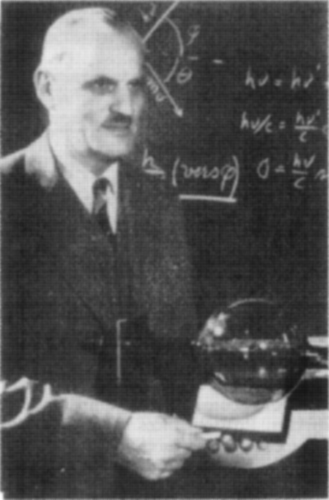
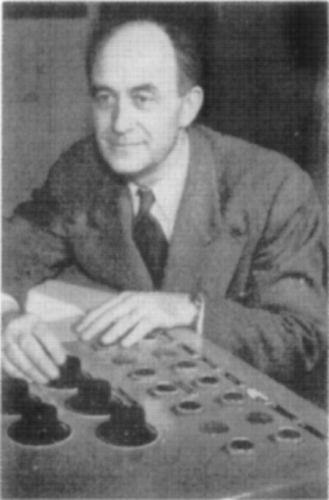
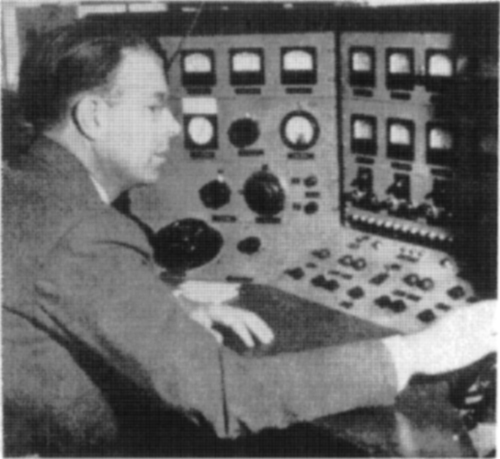
Ernest O. Lawrence, above, director of the Radiation Laboratory at the University of California, at the panel of a cyclotron; Arthur H. Compton, left, director of the Metallurgical Laboratory, University of Chicago; Enrico Fermi, below left, who built the first atomic reactor at Chicago; and, below right, Albert Einstein with Harold C. Urey, who directed the research at the SAM Laboratories at Columbia University.
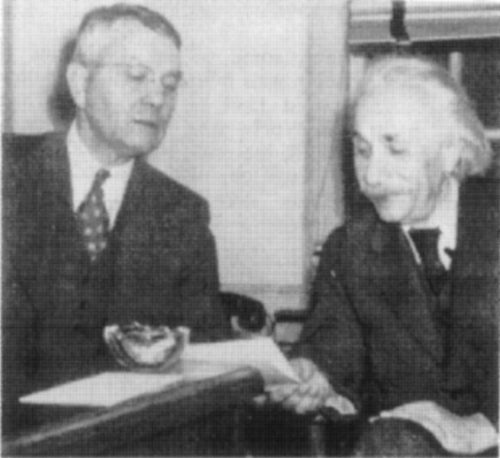
(All picture Wide World photos)
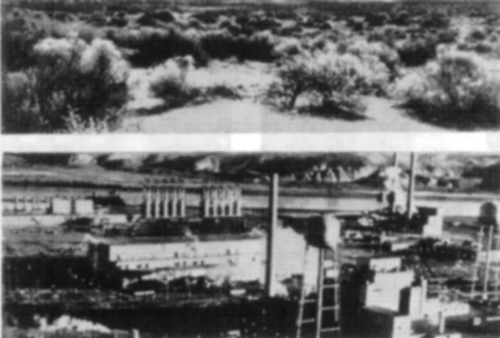
Typical Haniord scene (top) before construction; sbove. a completed reactor at ilanford in operation; left, construction workers at Ilanford; kind opposite page, top, the Man ford construction camp, which hodstx! 45,000 wotkers. Piojcct offices of U.S. Corps of Engineers and du Pont are in foreground.
(du Pont Pttoto Library)
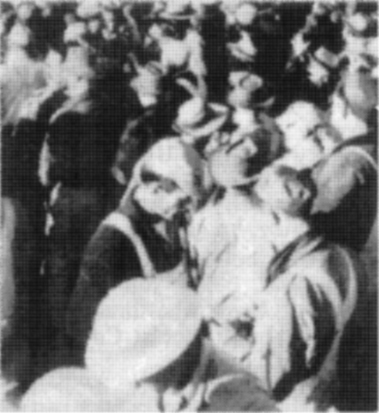
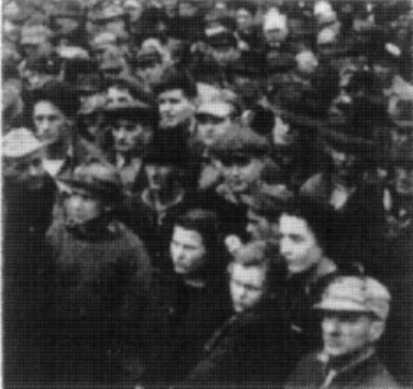
Right, some of the thousands of people who built Oak Ridge; below, view in 1942 of the Clinton Engineer Works area, where the city of Oak Ridge was built (MED photos); and opposite page, below, the i-ir-eou; diffusion plant at Oak Ridee.
(USAEC photo)
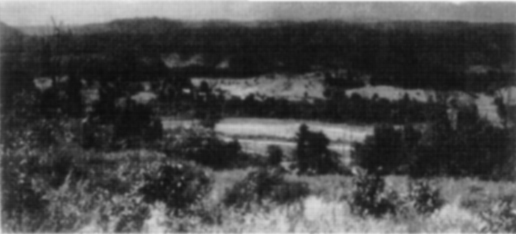
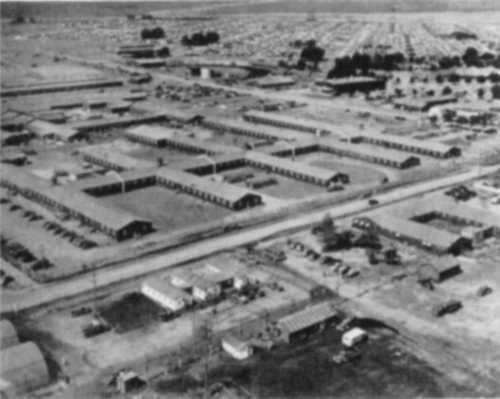
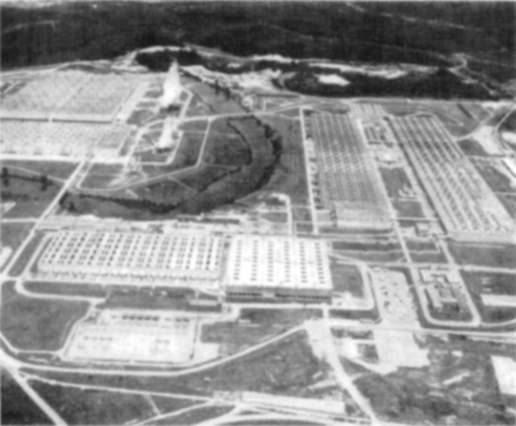
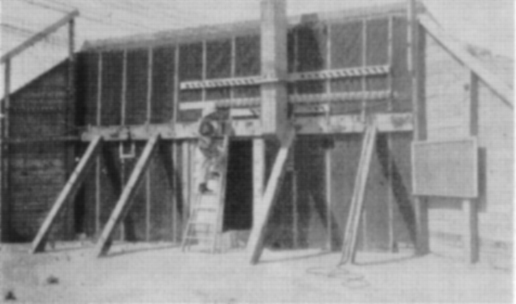
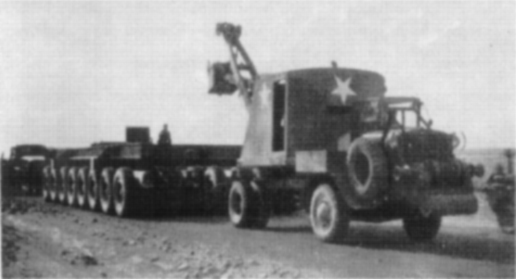
Top, the control dugout ai Airauogoido, “he point from which the bomb was actually fired. Above, the carrier for Jumbo. When loaded, it was drawn by two heavy tractors, Left, Jumbo after the blast. Horses also helped to usher in the atomic age. Below, some of the mounted guards at Los Alamos.
(MED photos)
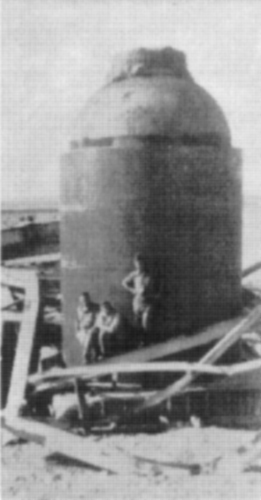
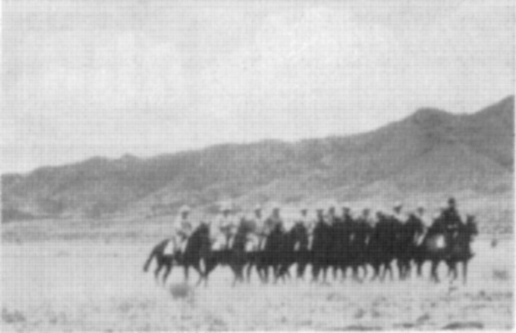
A scientific discussion in the author’s office. Left to right, Sir James Chadwick, the senior British scientific adviser; General Groves; and Richard C. Tolman, one of the tatter’s two senior American scientific advisers.
(U.S. Army photo)
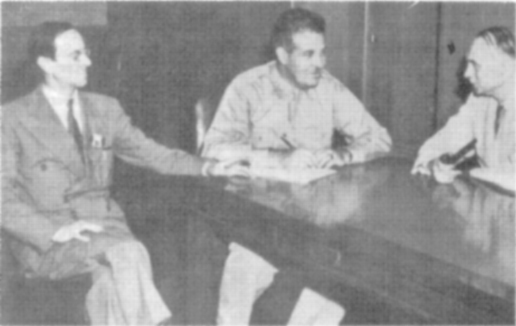
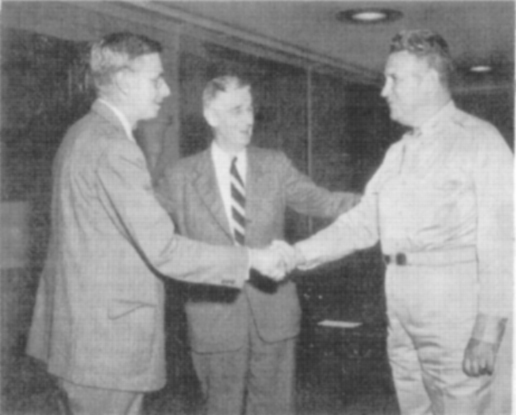
Left to right, James B, Conant, Chairman of the National Defense Research Committee, the other senior scientific adviser to General Groves; Vannevar Bush, Chairman of the Office of Scientific Research and Developiiieet; and General Groves, Commanding Ocneroi, Manhattan Eogineer District.
(MED photo)
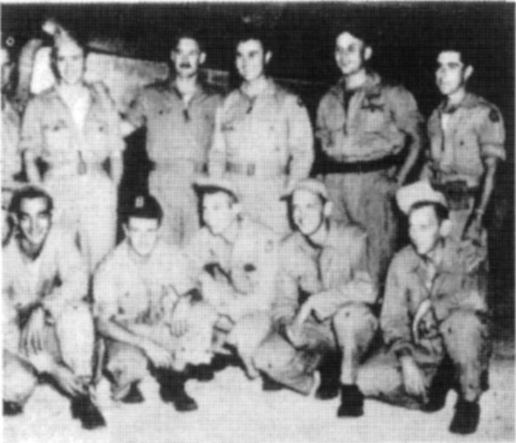
The air crew of the Hiroshima bombing. Standing, left to right, Lt. Col. John Porter, ground maintenance officer; Capt. Theodore J. Van Kirk, navigator; Maj. Thomas W. Ferebee, bombardier; Col. Paul W. Tibbets, pilot: Capt. Robert A. Lewis, co-pilot; and Lt. Jacob Beser, radar counter-measure officer. Front row, left to right, Sgt. Joseph Stiborik, radar operator: Sgt. George R. Caron, tail gunner; Cpl. Richard H. Nelson, radio operator; Sgt. Robert H. Shumard, assistant flight engineer; and T/Sgt. Wyatt E, Duzenberry, flight engineer. Not shown: the weaponeer, Capi. W. S. Parsons, USN, and his assistant, Lt. M. R. Jeppson.
(Official IKS. Air Force photo)
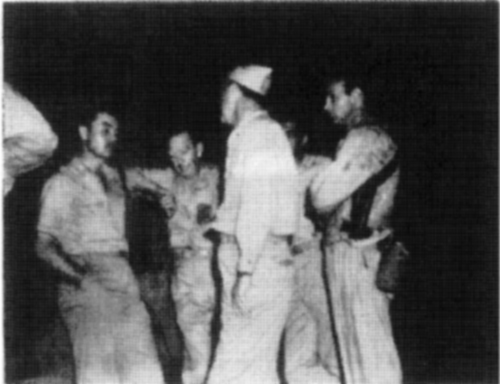
Ten minutes before the take-off for Nagasaki, Left to right Col. Paul W, Tibbcts: Rear Adm. W. R. E. Purnell; Capt. William S. Parsons (with cap); and, in his flight equipment, Comdr. F. L, Ashworth, the weaponeer.
(MED photo)
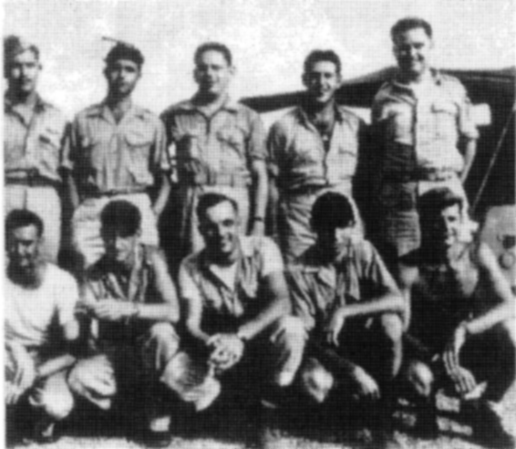
The air crew of the Nagasaki bombing. Front row, left to light, S/Sgt. Edward Buckley,, radar operator; M/Sgt. John Kuharek, flight engineer; Sgt. Raymond Gailaghei. assistant flight engineer: S/Sgt. Albert Oehart, tail gunner, and Sgt. Abe Spitzer. Standing, left to right, Capt. Kermit K. Beahan, bombardier; Capt. James F. Van Pelt, Jr., navigator; Capt. Charles D. Albury, co-pilot on this flight (normally airplane commander); Lt. Fred J. Olivi. third pilot (normally co-pilot); and Maj. Charles W. Sweeney, pilot. Not shown: the weaponeer, Comdr. F. L, Asworth, USN, and his assistant, Lt. P. M. Barnes.
(Official U.S. Air Force photo)
The now familiar smoke column over Nagasaki (opposite page) just after the bombing on August 9, 1945. Note wing of escort plane in lower right corner.
(Official U.S. Air Force photo)
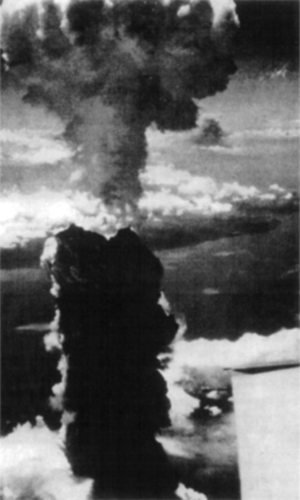
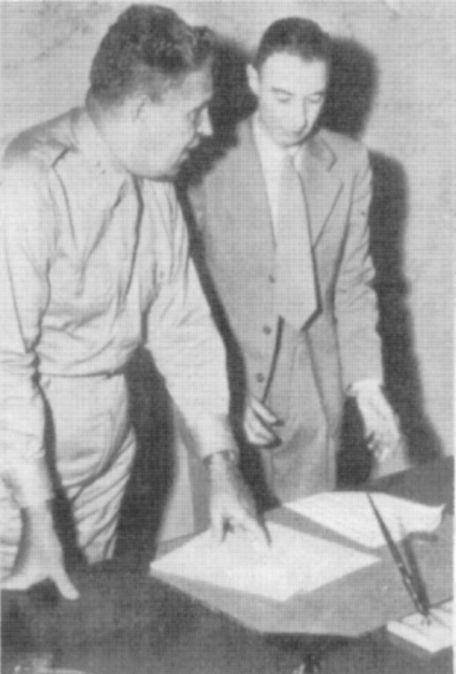
“the author with 3. Robert Oppenheimer, who headed the Los Alamos Laboratory.
(MED photo)
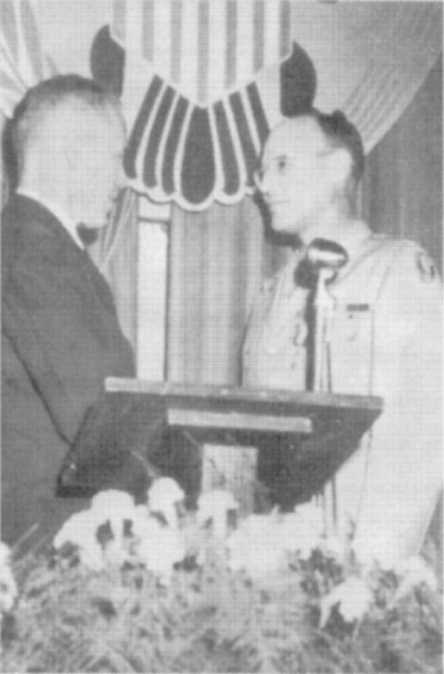
Secretary of War Robert Patterson awarding the Distinguished Service Medal to Brig. Gen. Kenneth D, Nichols, the District Engineer, to whom much of the success of the project was due. The MED shoulder patch was authorised a few days after the Hiroshima bombing; it was worn by several thousand military personnel assigned to the project.
(MED photo)
In the meantime, Pash was about twenty miles ahead of the advanced elements of the Seventh Army as they pushed through the Bavarian Alps. Finding the bridge into Urfeld destroyed, his group of eight dismounted from their vehicles and joined a ten-man reconnaissance patrol, entering Urfeld in the late afternoon of May 2. About an hour later, a German unit tried to pass through the town and a hot fire fight broke out. Shortly afterward, the patrol withdrew, leaving Pash in control of the town but alone. I could never straighten out in my own mind just what happened that night. But the following will give a general picture.
At sundown Pash was told that a German general wished to see him. The general was admitted and immediately surrendered his entire division to the very surprised chief of the Alsos mission. Pash, thinking fast, replied that it was getting late and he did not wish to bother his own general, who was right behind him with a large force, with any formalities that night; so the Germans would have to wait until morning to have their surrender officially accepted. No sooner had the first general departed than another German commander, this time of seven or eight hundred men, arrived and the procedure was repeated. By now, Pash was thoroughly alarmed for the safety of his infinitesimal force, and, as soon as it became thoroughly dark, he withdrew quietly toward the American lines. Shortly before this he had found Heisenberg, but with the difficult situation confronting him he felt it wiser to leave him in his home for the time being. During the night, he was able to obtain the support of an infantry battalion. He returned at dawn on May 3 and picked up Heisenberg, who was waiting in an office with his bag already packed. When Pash entered, Heisenberg greeted him with: “I have been expecting you.” Heisenberg was immediately evacuated to Heidelberg.
Pash’s last effort typified the boldness with which he carried out every one of his operations, and clearly demonstrated his ability to stick to his objective, which, in this case, had been to catch Heisenberg. Heisenberg was one of the world’s leading physicists and, at the time of the German break-up, he was worth more to us than ten divisions of Germans. Had he fallen into Russian hands, he would have proven invaluable to them. As it was, he has always remained on the side of the West. Judging from other actions taken at that time, we seemed to be almost alone in our appreciation of the potential value of German scientists to the Russians.
With Heisenberg in our custody, all his colleagues began to talk freely. We soon learned that, although Gerlach had been in administrative charge of the work, he had only a superficial knowledge of its technical details. Diebner was not particularly co-operative and seemed to be rather antagonistic toward Heisenberg. Gerlach and Heisenberg were on cordial terms and appeared to consider Diebner an inferior scientist. Heisenberg was, outwardly at least, actively anti-Nazi, but was nevertheless strongly nationalistic. None of them seemed to know very much about the Allies’ nuclear fission efforts; Gerlach spoke several times of the poor quality of German technical intelligence. There was no German counterpart of Alsos.
After Hamburg fell, Harteck was captured. He had written a letter on April 24, 1939, in which he advised the War Ministry that:
We take the liberty of calling to your attention the newest development in nuclear physics which in our opinion will perhaps make it possible to produce an explosive which is many orders of magnitude more effective than the present one ... it is obvious that if the possibility of energy production outlined above can be realized, which certainly is within the realm of possibility, that country which first makes use of it, has an unsurpassable advantage over the others.
However, Harteck, like the other German scientists, seemed to have come to feel that, while there was some hope of producing energy from a uranium pile, it was unlikely, if not entirely impossible, that a workable weapon could be developed.
The various possibilities open to the Germans were never systematically and completely investigated. This was because their work was seriously deficient in over-all direction, unity of purpose and coordination between the participating agencies. Originally, there had been a number of more or less competing groups, one under Army Ordnance, another under the Kaiser Wilhelm Institute of Physics, and still another under the Postal Department. There was continual bickering, as might be expected, over supplies and material, and surprisingly enough, in the light of most American scientists’ pleas for freedom from the restrictions of compartmentalization, there was a generally nonco-operative attitude regarding the exchange of information between the various groups. Many German scientists worked alone on their individual projects and did not seem to feel any compulsion to work for the national interest. The basic reason for this was probably the generally accepted belief that the development of a nuclear weapon was not possible.
In any case, the development of nuclear energy in Germany never got beyond the laboratory stage, and even there the principal consideration was its use for power rather than for explosives. Other scientific objectives seemed to be more important and received greater governmental attention and support.
The status of the German effort at the close of the war in Europe was reminiscent of the early phases of our project in the United States, when committees were appointed only to be superseded by other committees. At times it seemed as though more thought had to be devoted to organization than to solving the problems under study.
The German National Research Council had been under the Ministry of Education until 1943, when it began to function as a central agency for research work with possible military applications. About a year after its formation, it was placed directly under Goring. It assigned research projects to universities and individuals, allocated funds, established priorities and handled scientific personnel.
In the fall of 1944, Himmler’s Security Service Organization apparently became interested in the atomic project and formed a War Research Pool, which remained under Goring to avoid duplication and useless work. Himmler’s people did not seem to be entirely satisfied with progress under the National Research Council, however, and they subsequently proposed a plan to remove all obstacles to the project and obtain maximum results. Although this plan was sound, it came too late.
The Germans carried out their centrifuge research at Celle. This work had started at the University of Hamburg under Dr. Harteck, but had to be relocated several times because of Allied bombings. It finally moved into the spinning mill near Hechingen, where it was seized by Alsos. The equipment was very small in comparison to our own, but it seemed to be operating satisfactorily.
The German scientists whom we had assembled at Rheims—Hahn, von Laue, von Weizsäxcker, Wertz, Bagge and Korshing—seemed fairly content with their lot and, having given their parole not to leave the house in which they were billeted, settled down quickly to their new routine. But on May 7, they were moved to Versailles, where they were subjected to treatment that I considered entirely unacceptable in that they were not segregated from other prisoners of war. The scientists themselves were most indignant at being considered war criminals and repeatedly asked to see Joliot. A couple of days later this group was joined by Heisenberg and Diebner, and discontent continued to grow until we found it necessary to do something about it. The principal trouble stemmed from a SHAEF order that prohibited preferential treatment for any German national.
I succeeded, on May 11, in having our guests moved to Le Vésinet, where the situation quickly began to improve. The professors were well pleased with conditions there in spite of the dismaying plumbing and electrical problems with which they were confronted. As a matter of fact, they kept themselves occupied and amused for a time in repairing and restoring these essential services. However, we soon began to run into trouble with the troop units in the areas, as well as with the French local inhabitants who accused our officer-in-charge of harboring Marshal Pétain. To counteract this, we put out the story that the group consisted of active anti-Nazis whom we were holding in protective custody.
Nevertheless, it was obvious that the scientists soon would have to move again, and, on the fourth of June they were taken to Huy in Belgium. There, our troubles began all over again because the local commander insisted upon issuing POW rations to the professors. By this time they were becoming quite upset by the lack of contact with their families and with other scientists that had been promised them when we took them into custody. Fortunately, their house at Huy contained a broken piano and they kept busy for a while repairing it. Trouble began in earnest, however, when they read in their newspapers of the extension of the Russian zone in occupied Germany to include Dr. Diebner’s home in Thuringia. This was a serious matter from my point of view, too, since Frau Diebner had worked with her husband throughout the war on everything that he had done. After a frantic search, we were relieved to learn that she had moved to Neustadt in the American zone.
Dr. Gerlach joined the troupe at Huy on the fourteenth. By now they were all definitely unhappy. It was during this period that Heisenberg indicated that the documents that the Alsos mission had captured were misleading, because the German scientists had progressed much further in their work than they had indicated in their reports, and because their knowledge had advanced materially since we had brought them together in custody and made it possible for them to exchange information.
On July 3, the group was sent by plane to England. Upon arriving there, they were taken to a country estate called Farm Hall, which had been thoroughly prepared for their arrival and custody. I was most amused to read, therefore, the transcript of one of their early conversations:1
Diebner: I wonder whether there are microphones installed here?
Heisenberg: Microphones installed? (Laughing) Oh, no, they’re not as cute as all that. I don’t think they know the real Gestapo methods; they’re a bit old-fashioned in that respect.
Immediately the group began working hard to build up a legal case against their detention. This was a period of much conjecture for them. Some thought the British would not let them have any contact with British scientists, because, Heisenberg suggested, the British Government were frightened about some of the professors. “They say,” Heisenberg continued, “ ‘if we tell Dirac or Blackett where they are, they will report it immediately to their Russian friend Kapitza, and Comrade Stalin will come and say: “What about the Berlin University professors? They belong in Berlin,” and it is possible that the Big Three will decide it at Potsdam and then Churchhill will come back and say: “Off you go” and the whole group is to return to Berlin and then we’ll be in the soup.’ “
Suspicions of each other’s motives cropped up during this period and there were frequent displays of temper at the manner in which some of the professors had voluntarily surrendered their secrets. At the same time, the group was beset by doubt and a sense of insecurity. They were greatly concerned about the continued lack of news from their families and there was considerable speculation about what we were doing in the field of atomic energy. Said Bagge: “I am convinced they [the Anglo-Americans] have used these last three months mainly to imitate our experiments.”
After V-E Day, a number of searches for specific information and materials were conducted in various parts of Germany. Alsos sent groups to Berlin and Salzburg, but, by that time, I was no longer too much concerned with their work, beyond insuring that no information remained that might eventually fall into Russian hands. These operations only confirmed what we already knew and it was quite clear that there was nothing in Europe of further interest to us.
By the end of the war, the value of Alsos had been demonstrated in so many ways that there was a strong current of opinion in favor of continuing the organization, suitably transformed, as a permanent instrument, under G-2, for the collection of scientific intelligence information. As to whether or not this was feasible, there were arguments in both directions. Subsequent history has certainly proved the need for prompt and accurate information on the progress of potential enemies in such fields as rocket fuels, satellite guidance, thermonuclear reactions, seismology and biological weapons. Again this is a broad problem, outside the present story. The fact is that Alsos, after considerable discussion and against the wishes of the lower levels of G-2, was broken up shortly after the end of the war. The 114 men and women who were with the mission on V-E Day (28 officers, 43 enlisted men, 19 scientists, 5 civilian employees and 19 CIC agents) were gradually reduced by attrition until, on October 15, 1945, the “MED Scientific Intelligence (Alsos) Mission” was officially disbanded.
1 All reported conversations were translated from the spoken German.